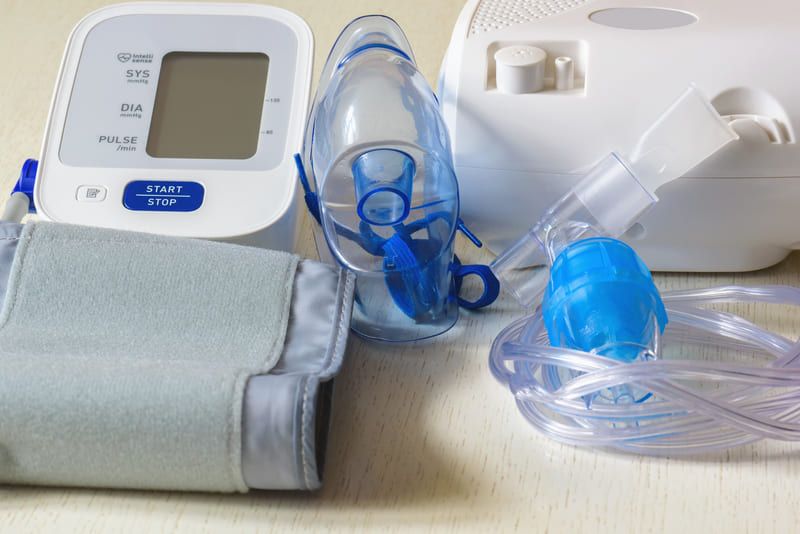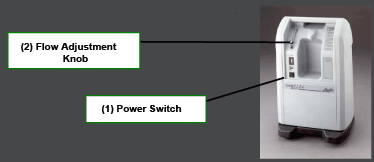Respiratory

Oxygen Concentrator
An oxygen concentrator takes in room air (21% oxygen) and converts it into more pure oxygen (>90% oxygen). This process does not reduce the 21% oxygen in the rest of the room.

Using Your Oxygen Concentrator
1. Plug into a properly grounded outlet. (do NOT use extension cord, an outlet attached to a wall switch or multi plug adaptors).
2. Turn the power switch (1) to “on”.
3. Turn the flow adjustment knob (2) to your prescribed liter flow (see above under “Your Prescription”). The indicator ball should be centered on the LPM line.
4. Attach the end of the cannula or additional tubing.
Concentrator Cleaning And Maintenance…
You should clean the filter at least once a week. You can wash the filter with tap water and squeeze dry with a clean towel. You should not use your concentrator without the filter. You should also wipe down the concentrator with a damp cloth periodically. We will schedule an appointment to come to your home to perform a detailed maintenance check approximately every 3 months.
Portable Oxygen Systems
You should have oxygen cylinders to assist you when moving outside of your concentrators reach and for emergency back-up in case of a power failure.
Turning Your Portable Oxygen On...
1. Remove the plastic wrapper on the post valve (nozzle) of the tank.
2. Make sure the washer (1) in on the regulator.
3. Place the regulator on the tank, make sure the pegs align for snug fit.
4. Tighten the “T” Bolt (2) firmly.
Note: if these four steps aren’t followed, the cylinder will make a loud hissing sound … there is no danger to this, just turn off, and re-check the washer, peg alignment, and the re-tighten the “T” Bolt.

5. Using the small cylinder wrench (key), slowly turn counter-clockwise 1 full turn. When the valve is opened, the pressure gauge (3) will indicate the amount of oxygen in the tank (2000 psi is full).
6. Turn the flow adjustment knob (4) until it shows the liter flow prescribed by your physician.
7. Attach cannula tubing to the nipple adaptor on regulator.
8. Put cannula on and place comfortably in nose.
Turning Your Portable Oxygen Off & Removing The Regulator…
1. Using the small cylinder wrench (key), slowly turn the cylinder valve clockwise until snug; the pressure gauge will drop to zero.
2. Turn the flow know to “off”.
3. Loosen the “T” Bolt until it allows the regulator to come free of the tank valve.
Getting Used To Your Nasal Cannula
You should point the nasal prongs towards you, place the small tubes up over your ears and under the chin, then push the slide up until a snug, comfortable fit is achieved. You do not have to always breathe through your nose. If your nose becomes irritated, you may want to use a water-based lubricant inside your nostrils. If the irritation persists, contact your physician. You should change your cannulas every month. You should always call 800-892-4044 to re-order cannulas when you have 1 unused one on hand.
If You Have A Conserving Device...
An oxygen conserving device must be prescribed by your doctor. The purpose is to make your oxygen cylinder (tank) last longer. At the start of your inhalation, the conserving device immediately releases a short pulsed dose of oxygen, rather than a continuous flow that is given without the conserving device. Most conserving devices require batteries, therefore, make sure you keep extra batteries on hand. You should breathe normally when using the conserving device. Since each individual’s breathing pattern is different, the amount of time a cylinder lasts will vary slightly. Click here to view a chart of the cylinders and their duration.
Installing the conserving device is similar to installing a regulator. Follow the steps listed above along with the instructions provided by the manufacturer and your DASCO representative.
Do not use a humidifier with a conserving device, avoid exposure to liquid and be sure to keep extra batteries handy.
Sleep Therapy
- CPAP/BIPAP
- Masks and supplies
- Humidification
- Compliance assistance
Aerosol Therapy
- Nebulizers
- Medications
